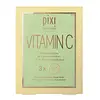What's inside
What's inside
 Key Ingredients
Key Ingredients

 Benefits
Benefits

 Concerns
Concerns

 Ingredients Side-by-side
Ingredients Side-by-side

Water
Skin ConditioningDipropylene Glycol
HumectantGlycerin
Humectant1,2-Hexanediol
Skin ConditioningGlucose
Humectant3-O-Ethyl Ascorbic Acid
Skin ConditioningCaffeine
Skin ConditioningFerulic Acid
AntimicrobialCamellia Sinensis Leaf Extract
AntimicrobialCitrus Aurantium Dulcis Peel Oil
MaskingGlycyrrhiza Glabra Root Extract
BleachingCitrus Limon Fruit Extract
MaskingHippophae Rhamnoides Fruit Extract
Skin ConditioningNiacinamide
SmoothingSodium Hyaluronate
HumectantEthylhexylglycerin
Skin ConditioningXanthan Gum
EmulsifyingPolyglyceryl-4 Caprate
EmulsifyingPropanediol
SolventCellulose Gum
Emulsion StabilisingLimonene
PerfumingWater, Dipropylene Glycol, Glycerin, 1,2-Hexanediol, Glucose, 3-O-Ethyl Ascorbic Acid, Caffeine, Ferulic Acid, Camellia Sinensis Leaf Extract, Citrus Aurantium Dulcis Peel Oil, Glycyrrhiza Glabra Root Extract, Citrus Limon Fruit Extract, Hippophae Rhamnoides Fruit Extract, Niacinamide, Sodium Hyaluronate, Ethylhexylglycerin, Xanthan Gum, Polyglyceryl-4 Caprate, Propanediol, Cellulose Gum, Limonene
Water
Skin ConditioningButylene Glycol
HumectantPropanediol
SolventGlycerin
HumectantRubus Chamaemorus Fruit Extract
AntioxidantRubus Chamaemorus Seed Extract
Skin ConditioningPhenoxyethanol
PreservativeBetaine
HumectantPEG-40 Hydrogenated Castor Oil
EmulsifyingSaccharide Isomerate
HumectantAscorbyl Glucoside
AntioxidantXylitylglucoside
HumectantSodium Hyaluronate
HumectantXanthan Gum
EmulsifyingAnhydroxylitol
HumectantTrehalose
HumectantUrea
BufferingDisodium EDTA
Hydrolyzed Hyaluronic Acid
HumectantMaltodextrin
AbsorbentXylitol
HumectantEthylhexylglycerin
Skin ConditioningSodium Hydroxide
BufferingSodium Citrate
BufferingAdenosine
Skin ConditioningPentylene Glycol
Skin ConditioningSerine
MaskingCitric Acid
BufferingAlgin
MaskingCaprylyl Glycol
EmollientDisodium Phosphate
BufferingGlyceryl Polyacrylate
Pullulan
Potassium Phosphate
BufferingLimonene
PerfumingLinalool
PerfumingCitral
PerfumingParfum
MaskingWater, Butylene Glycol, Propanediol, Glycerin, Rubus Chamaemorus Fruit Extract, Rubus Chamaemorus Seed Extract, Phenoxyethanol, Betaine, PEG-40 Hydrogenated Castor Oil, Saccharide Isomerate, Ascorbyl Glucoside, Xylitylglucoside, Sodium Hyaluronate, Xanthan Gum, Anhydroxylitol, Trehalose, Urea, Disodium EDTA, Hydrolyzed Hyaluronic Acid, Maltodextrin, Xylitol, Ethylhexylglycerin, Sodium Hydroxide, Sodium Citrate, Adenosine, Pentylene Glycol, Serine, Citric Acid, Algin, Caprylyl Glycol, Disodium Phosphate, Glyceryl Polyacrylate, Pullulan, Potassium Phosphate, Limonene, Linalool, Citral, Parfum
 Reviews
Reviews

Ingredients Explained
These ingredients are found in both products.
Ingredients higher up in an ingredient list are typically present in a larger amount.
Ethylhexylglycerin (we can't pronounce this either) is commonly used as a preservative and skin softener. It is derived from glyceryl.
You might see Ethylhexylglycerin often paired with other preservatives such as phenoxyethanol. Ethylhexylglycerin has been found to increase the effectiveness of these other preservatives.
Glycerin is already naturally found in your skin. It helps moisturize and protect your skin.
A study from 2016 found glycerin to be more effective as a humectant than AHAs and hyaluronic acid.
As a humectant, it helps the skin stay hydrated by pulling moisture to your skin. The low molecular weight of glycerin allows it to pull moisture into the deeper layers of your skin.
Hydrated skin improves your skin barrier; Your skin barrier helps protect against irritants and bacteria.
Glycerin has also been found to have antimicrobial and antiviral properties. Due to these properties, glycerin is often used in wound and burn treatments.
In cosmetics, glycerin is usually derived from plants such as soybean or palm. However, it can also be sourced from animals, such as tallow or animal fat.
This ingredient is organic, colorless, odorless, and non-toxic.
Glycerin is the name for this ingredient in American English. British English uses Glycerol/Glycerine.
Learn more about GlycerinLimonene is a fragrance that adds scent and taste to a formulation.
It's found in the peel oil of citrus fruits and other plants such as lavender and eucalyptus. The scent of limonene is generally described as "sweet citrus".
Limonene acts as an antioxidant, meaning it helps neutralize free radicals.
When exposed to air, oxidized limonene may sensitize the skin. Because of this, limonene is often avoided by people with sensitive skin.
The term 'fragrance' is not regulated in many countries. In many cases, it is up to the brand to define this term. For instance, many brands choose to label themselves as "fragrance-free" because they are not using synthetic fragrances. However, their products may still contain ingredients such as essential oils that are considered a fragrance.
Learn more about LimonenePropanediol is an all-star ingredient. It softens, hydrates, and smooths the skin.
It’s often used to:
Propanediol is not likely to cause sensitivity and considered safe to use. It is derived from corn or petroleum with a clear color and no scent.
Learn more about PropanediolSodium Hyaluronate is hyaluronic acid's salt form. It is commonly derived from the sodium salt of hyaluronic acid.
Like hyaluronic acid, it is great at holding water and acts as a humectant. This makes it a great skin hydrating ingredient.
Sodium Hyaluronate is naturally occurring in our bodies and is mostly found in eye fluid and joints.
These are some other common types of Hyaluronic Acid:
Learn more about Sodium HyaluronateWater. It's the most common cosmetic ingredient of all. You'll usually see it at the top of ingredient lists, meaning that it makes up the largest part of the product.
So why is it so popular? Water most often acts as a solvent - this means that it helps dissolve other ingredients into the formulation.
You'll also recognize water as that liquid we all need to stay alive. If you see this, drink a glass of water. Stay hydrated!
Learn more about WaterXanthan gum is used as a stabilizer and thickener within cosmetic products. It helps give products a sticky, thick feeling - preventing them from being too runny.
On the technical side of things, xanthan gum is a polysaccharide - a combination consisting of multiple sugar molecules bonded together.
Xanthan gum is a pretty common and great ingredient. It is a natural, non-toxic, non-irritating ingredient that is also commonly used in food products.
Learn more about Xanthan Gum